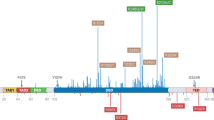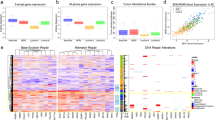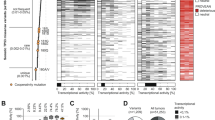Abstract
Wild-type p53 is a stress-responsive tumor suppressor and potent growth inhibitor. Genotoxic stresses (for example, ionizing and ultraviolet radiation or chemotherapeutic drug treatment) can activate p53, but also induce mutations in the P53 gene, and thus select for p53-mutated cells. Nutlin-3a (Nutlin) is pre-clinical drug that activates p53 in a non-genotoxic manner. Nutlin occupies the p53-binding pocket of murine double minute 2 (MDM2), activating p53 by blocking the p53–MDM2 interaction. Because Nutlin neither binds p53 directly nor introduces DNA damage, we hypothesized Nutlin would not induce P53 mutations, and, therefore, not select for p53-mutated cells. To test this, populations of SJSA-1 (p53 wild-type) cancer cells were expanded that survived repeated Nutlin exposures, and individual clones were isolated. Group 1 clones were resistant to Nutlin-induced apoptosis, but still underwent growth arrest. Surprisingly, while some Group 1 clones retained wild-type p53, others acquired a heterozygous p53 mutation. Apoptosis resistance in Group 1 clones was associated with decreased PUMA induction and decreased caspase 3/7 activation. Group 2 clones were resistant to both apoptosis and growth arrest induced by Nutlin. Group 2 clones had acquired mutations in the p53-DNA-binding domain and expressed only mutant p53s that were induced by Nutlin treatment, but were unable to bind the P21 and PUMA gene promoters, and unable to activate transcription. These results demonstrate that non-genotoxic p53 activation (for example, by Nutlin treatment) can lead to the acquisition of somatic mutations in p53 and select for p53-mutated cells. These findings have implications for the potential clinical use of Nutlin and other small molecule MDM2 antagonists.
This is a preview of subscription content, access via your institution
Access options
Subscribe to this journal
Receive 50 print issues and online access
$259.00 per year
only $5.18 per issue
Buy this article
- Purchase on Springer Link
- Instant access to full article PDF
Prices may be subject to local taxes which are calculated during checkout




Similar content being viewed by others
References
Ahmed AA, Etemadmoghadam D, Temple J, Lynch AG, Riad M, Sharma R et al. (2010). Driver mutations in TP53 are ubiquitous in high grade serous carcinoma of the ovary. J Pathol 221: 49–56.
Ashkenazi A . (2008). Targeting the extrinsic apoptosis pathway in cancer. Cytokine Growth Factor Rev 19: 325–331.
Blagosklonny MV . (2002). Oncogenic resistance to growth-limiting conditions. Nat Rev Cancer 2: 221–225.
Blagosklonny MV . (2005). Carcinogenesis, cancer therapy and chemoprevention. Cell Death Differ 12: 592–602.
Brown L, Boswell S, Raj L, Lee SW . (2007). Transcriptional targets of p53 that regulate cellular proliferation. Crit Rev Eukaryot Gene Expr 17: 73–85.
Christiansen DH, Andersen MK, Pedersen-Bjergaard J . (2001). Mutations with loss of heterozygosity of p53 are common in therapy-related myelodysplasia and acute myeloid leukemia after exposure to alkylating agents and significantly associated with deletion or loss of 5q, a complex karyotype, and a poor prognosis. J Clin Oncol 19: 1405–1413.
De Benedetti VM, Travis LB, Welsh JA, van Leeuwen FE, Stovall M, Clarke EA et al. (1996). p53 mutations in lung cancer following radiation therapy for Hodgkin's disease. Cancer Epidemiol Biomarkers Prev 5: 93–98.
Drakos E, Thomaides A, Medeiros LJ, Li J, Leventaki V, Konopleva M et al. (2007). Inhibition of p53-murine double minute 2 interaction by nutlin-3A stabilizes p53 and induces cell cycle arrest and apoptosis in Hodgkin lymphoma. Clin Cancer Res 13: 3380–3387.
Efeyan A, Serrano M . (2007). p53: guardian of the genome and policeman of the oncogenes. Cell Cycle 6: 1006–1010.
Fulci G, Labuhn M, Maier D, Lachat Y, Hausmann O, Hegi ME et al. (2000). p53 gene mutation and ink4a-arf deletion appear to be two mutually exclusive events in human glioblastoma. Oncogene 19: 3816–3822.
Gaitonde SV, Riley JR, Qiao D, Martinez JD . (2000). Conformational phenotype of p53 is linked to nuclear translocation. Oncogene 19: 4042–4049.
Haupt Y, Maya R, Kazaz A, Oren M . (1997). Mdm2 promotes the rapid degradation of p53. Nature 387: 296–299.
Hollstein M, Sidransky D, Vogelstein B, Harris CC . (1991). p53 mutations in human cancers. Science 253: 49–53.
Horn HF, Vousden KH . (2007). Coping with stress: multiple ways to activate p53. Oncogene 26: 1306–1316.
Kubbutat MH, Jones SN, Vousden KH . (1997). Regulation of p53 stability by Mdm2. Nature 387: 299–303.
Kumamoto K, Spillare EA, Fujita K, Horikawa I, Yamashita T, Appella E et al. (2008). Nutlin-3a activates p53 to both down-regulate inhibitor of growth 2 and up-regulate mir-34a, mir-34b, and mir-34c expression, and induce senescence. Cancer Res 68: 3193–3203.
Leonard DG, Travis LB, Addya K, Dores GM, Holowaty EJ, Bergfeldt K et al. (2002). p53 mutations in leukemia and myelodysplastic syndrome after ovarian cancer. Clin Cancer Res 8: 973–985.
Lovric MM, Hawkins CJ . (2010). TRAIL treatment provokes mutations in surviving cells. Oncogene 29: 5048–5060.
Maki CG, Howley PM . (1997). Ubiquitination of p53 and p21 is differentially affected by ionizing and UV radiation. Mol Cell Biol 17: 355–363.
Maltzman W, Czyzyk L . (1984). UV irradiation stimulates levels of p53 cellular tumor antigen in nontransformed mouse cells. Mol Cell Biol 4: 1689–1694.
Mayelzadeh F, Martinez JD . (2007). DNA binding and selective gene induction by different forms of the p53 protein. Oncogene 26: 2955–2963.
McDermott U, Longley DB, Galligan L, Allen W, Wilson T, Johnston PG . (2005). Effect of p53 status and STAT1 on chemotherapy-induced, Fas-mediated apoptosis in colorectal cancer. Cancer Res 65: 8951–8960.
Midgley CA, Lane DP . (1997). p53 protein stability in tumour cells is not determined by mutation but is dependent on Mdm2 binding. Oncogene 15: 1179–1189.
Mihara M, Erster S, Zaika A, Petrenko O, Chittenden T, Pancoska P et al. (2003). p53 has a direct apoptogenic role at the mitochondria. Mol Cell 11: 577–590.
Milner J, Medcalf EA . (1991). Cotranslation of activated mutant p53 with wild type drives the wild-type p53 protein into the mutant conformation. Cell 65: 765–774.
Peng Y, Chen L, Li C, Lu W, Chen J . (2001). Inhibition of MDM2 by hsp90 contributes to mutant p53 stabilization. J Biol Chem 276: 40583–40590.
Pietenpol JA, Lengauer C, Jordan J, Kinzler KW, Vogelstein B . (1996). Mammalian cells resistant to tumor suppressor genes. Proc Natl Acad Sci 93: 8390–8394.
Pinyol M, Hernandez L, Martinez A, Cobo F, Hernandez S, Bea S et al. (2000). INK4a/ARF locus alterations in human non-Hodgkin's lymphomas mainly occur in tumors with wild-type p53 gene. Am J Pathol 156: 1987–1996.
Shen H, Moran DM, Maki CG . (2008). Transient nutlin-3a treatment promotes endoreduplication and the generation of therapy-resistant tetraploid cells. Cancer Res 68: 8260–8268.
Sherr CJ, Weber JD . (2000). The ARF/p53 pathway. Curr Opin Genet Dev 10: 94–99.
Terzian T, Suh YA, Iwakuma T, Post SM, Neumann M, Lang GA et al. (2008). The inherent instability of mutant p53 is alleviated by Mdm2 or p16INK4a loss. Genes Dev 22: 1337–1344.
Thompson T, Tovar C, Yang H, Carvajal D, Vu BT, Xu Q et al. (2004). Phosphorylation of p53 on key serines is dispensable for transcriptional activation and apoptosis. J Biol Chem 279: 53015–53022.
Vaseva AV, Marchenko ND, Moll UM . (2009). The transcription-independent mitochondrial p53 program is a major contributor to nutlin-induced apoptosis in tumor cells. Cell Cycle 8: 1711–1719.
Vassilev LT, Vu BT, Graves B, Carvajal D, Podlaski F, Filipovic Z et al. (2004). In vivo activation of the p53 pathway by small-molecule antagonists of MDM2. Science 303: 844–848.
Wu GS, Ding Z . (2002). Caspase 9 is required for p53-dependent apoptosis and chemosensitivity in a human ovarian cancer cell line. Oncogene 21: 1–8.
Wu GS, El-Deiry WS . (1996). Apoptotic death of tumor cells correlates with chemosensitivity, independent of p53 or bcl-2. Clin Cancer Res 2: 623–633.
Acknowledgements
This work was supported by the National Cancer Institute grant 1RO1CA137598-01A1 to CGM.
Author information
Authors and Affiliations
Corresponding author
Ethics declarations
Competing interests
The authors declare no conflict of interest.
Additional information
Supplementary Information accompanies the paper on the Oncogene website
Rights and permissions
About this article
Cite this article
Aziz, M., Shen, H. & Maki, C. Acquisition of p53 mutations in response to the non-genotoxic p53 activator Nutlin-3. Oncogene 30, 4678–4686 (2011). https://doi.org/10.1038/onc.2011.185
Received:
Revised:
Accepted:
Published:
Issue Date:
DOI: https://doi.org/10.1038/onc.2011.185
Keywords
This article is cited by
-
Translating p53-based therapies for cancer into the clinic
Nature Reviews Cancer (2024)
-
miR-221/222 induce instability of p53 By downregulating deubiquitinase YOD1 in acute myeloid leukemia
Cell Death Discovery (2023)
-
PPM1D suppresses p53-dependent transactivation and cell death by inhibiting the Integrated Stress Response
Nature Communications (2022)
-
Resistance mechanisms to inhibitors of p53-MDM2 interactions in cancer therapy: can we overcome them?
Cellular & Molecular Biology Letters (2021)
-
Long transcripts minus touchdown qPCR (LTMT-qPCR): a simplified and convenient method for the screening and quantification of microRNA profile
Laboratory Investigation (2021)



